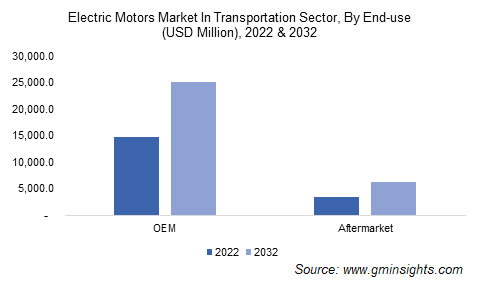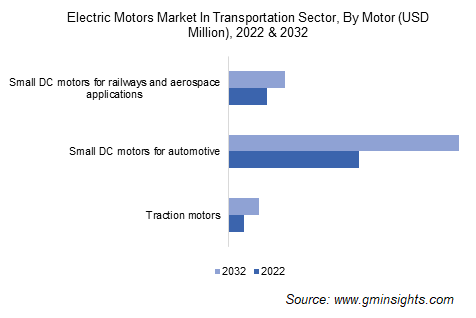Home > Automotive > Automotive Parts > Transmission and Drivetrain > Electric Motors Market
Electric Motors Market Analysis
- Report ID: GMI2144
- Published Date: Dec 2022
- Report Format: PDF
Electric Motors Market Analysis
Based on the motor, the electric motors market in transportation sector from small DC motors for automotive segment will exceed USD 22 billion by 2032. This motor is adopted for retracting, positioning, and extending electrically powered side windows, among other electric vehicle applications. Product demand is likely to remain strong, due to continued innovation to improve performance and costs. Key features also include high-speed range, noiseless operation, and faster dynamic response, leading to the widespread usage of small DC motors in the automotive industry.
Small DC motors for automotive segment is further segregated into cooling fans & blower motors, forklift actuation motors, vacuum pump motors, ABS motors, and air suspension motors categories. The ABS motors segment will depict a 6% CAGR through 2032, owing to their use as an alternative to conventional friction braking systems. These motors also ensure a superior braking performance and can save energy, thereby contributing to their development for EV applications.

The electric motors market size in transportation sector from the OEM end-use segment is expected to reach USD 25 billion by 2032, given the rising disposable income and improving economic conditions. Over the years, automobile manufacturers have been targeting to upgrade vehicle features through the deployment of advanced electric motors. Furthermore, the high emphasis on the production of different types of cars and railway vehicles will create lucrative opportunities for OEMs to design electric motors.

Regionally speaking, the North America electric motors market value in transportation sector is slated to exhibit a 5.5% CAGR till 2032, owing to the rise in living standards and healthy economic conditions is one of the prominent reasons driving electric motor development. Strict regulations have also been imposed to limit carbon emissions, encouraging manufacturers to integrate electric motors into their products. Additionally, with the increasing individual income levels, manufacturing output, and automobile innovations, product consumption is likely to further surge across the North American region.

